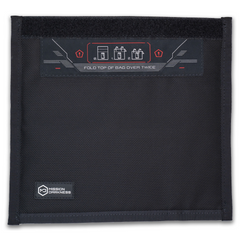The biggest mistake made during device collection is not using a faraday bag. If the device data is remotely wiped prior to analysis, the evidence is gone.
Extract digital evidence with ease using these steps
In today's world, cell phones have become an integral part of our lives. We use them for communication, entertainment, and for conducting business. As such, they have become a potential source of digital evidence that can be useful in criminal investigations or civil litigation. Digital forensics experts must use the latest tools to preserve digital evidence on cell phones to ensure the integrity and credibility of the evidence. However, cell phones are highly vulnerable to tampering, data corruption, and remote wiping. Therefore, it's essential to take the necessary steps to protect the data and prevent any changes or deletions. That's where faraday bags come in.
Faraday bags are designed to protect electronic devices from radio frequencies and electromagnetic radiation. They are made of conductive material that blocks out electromagnetic fields, which can interfere with the data on a phone. When you place a phone inside a faraday bag, it's shielded from external signals including Wi-Fi, Bluetooth, and cellular signals, which prevents anyone from tampering with the data or remotely wiping it.
The use of faraday bags has become an essential step in preserving digital evidence on cell phones. When a phone is collected or seized, it's important to keep it in a faraday bag to prevent any data from being lost, deleted, or altered. This is especially important for criminal investigations where evidence may be used in court.
The image above shows the Mission Darkness NeoLok Window Faraday Bag for Phones. This faraday bag model has a window on the front side constructed from special transparent faraday fabric to view device screens and ensure signal cutoff. It also has a patented NeoLok magnetic closure, making it safe to use with conductive gloves (if transferred to a forensic box). Standard faraday bags block signals effectively, but they do not include these added features which are beneficial for digital forensics use. Mission Darkness offers a wide range of faraday bags and analysis enclosures to meet the growing needs of industry professionals.
Step 1: Use a faraday bag to preserve digital evidence
The first step in preserving digital evidence on cell phones (and other communicable devices) is to secure the device in a faraday bag. Once the device is secured, it can be transported to a forensic lab for analysis.
It's important to note that keeping a device live may play a crucial role in breaking passcodes and extracting data. For that reason, Mission Darkness offers faraday bags with battery packs and USB filters to keep the device charged. There are additional factors to consider when choosing a faraday bag; read this article for help selecting the best bag for your needs and budget.
Step 2: Use a digital forensics tool to gain access to the device data
Advanced digital forensics tools are used to crack passcodes, extract data quickly, recover critical evidence, and therefore solve crimes faster.
In the lab, forensic experts use specialized software and tools to crack passcodes and extract data from the phone without altering or damaging it. This includes recovering deleted messages, call logs, and photos.
Step 3: Once data is extracted and analyzed, the information can be used to take cases to trial swiftly
Forensic experts also look for evidence of tampering or attempts to delete data. This information can be used in court to establish the authenticity of the evidence and the credibility of the investigation. By originally preserving the digital evidence in a faraday bag until the point of extraction or analysis, the integrity of the evidence is maintained, and the investigation can proceed with confidence.
Here's a video showing a Mission Darkness faraday bag being used as the first step in preserving data and recovery. It is used at the device collection site, then transported to the lab. From there, the device is connected to a forensic tool like GrayKey (a mobile device forensic tool for Android and iOS devices to lawfully access and extract encrypted or inaccessible data from devices). Data can then be analyzed and processed in order to solve cases or expedite trials involving the digital evidence obtained from the device.
There may be no data to access or uncover if a faraday bag isn't used; that is why it should always be factored into the evidence-handling process
In conclusion, faraday bags are an essential tool in preserving digital evidence on cell phones. They protect the device from external signals that can interfere with the data, and prevent anyone from tampering with or deleting it. By using faraday bags, forensic experts can extract data from the phone without altering or damaging it, which is crucial in criminal investigations or civil litigation. If you're dealing with a phone that may contain valuable evidence, be sure to secure it in a faraday bag as soon aas possible to ensure the integrity of the data.



